Herbal oxymel. An often tasty and simple herbal preparation made using vinegar and honey which has many benefits and uses.
This post may contain affiliate links at no additional cost to you. By making your purchases through the links on this website, IMSL may make a small percentage at no direct cost to you. IMSL only promotes products we use & truly believe in. Please refer to my Privacy & Disclosures for further information. IMSL thanks you for your support!
Each year before the end of the growing season, I turn my focus on creating herbal remedies that will support our immune systems and keep us healthy throughout the cold winter months. And that means creating my herbal remedies now to ensure I have them on hand when needed.
I do my best to gather herbs and utilize them for my medicinal applications (think tinctures, herbal infusions, and my homemade salves, moisturizers, and oils) to have them ready in my home apothecary, and dry to have them available for my culinary cabinet. And making my herbal oxymel’s are always on that to do list as well.
HERBAL OXYMEL DEFINED
So what exactly is an “oxymel”? Well, first can I say it’s an odd word in the English language for sure! The word itself having its roots stem back to ancient Greece, oxúmeli, Egypt, oxalme, and in Latin, oxymeli, translating to “acid and honey”. Interestingly, oxymels are also known by other names as well.
One of those names being “honegar”. Author D.C. Jarvis, M.D. refers to oxymels as “honegar” meaning honey & vinegar in Finnish in his book Folk Medicine.
An oxymel, dating back to their origins in both Persia & Greece, are very old, very efficacious herbal medicines that were created to make taking your “medicine” a bit tastier 😊
This herbal medicinal preparation is made using a base of a sweetener (honey) and vinegar (apple cider vinegar). Honey by nature is both a demulcent (reduces inflammation) & antibacterial (bacteria inhibitor) and vinegar (providing astringency or a strengthening of cells and bodily tissues through contraction).
Combined, honey & vinegar (when using ACV with the mother) can act as an expectorant, easing respiratory issues, act as a cooling febrifuge (fever reducer), and is restorative & energizing.
From there, other additions can be added to increase the medicinal and nutrient content of an oxymel. Think fresh herbs, herbal decoctions such as tinctures & infusions, lemon juice, and other ingredients (ginger etc) which will add to the medicinal & nutritive properties of the end product.
Sharing Is Caring & I thank you for it ❤️ …
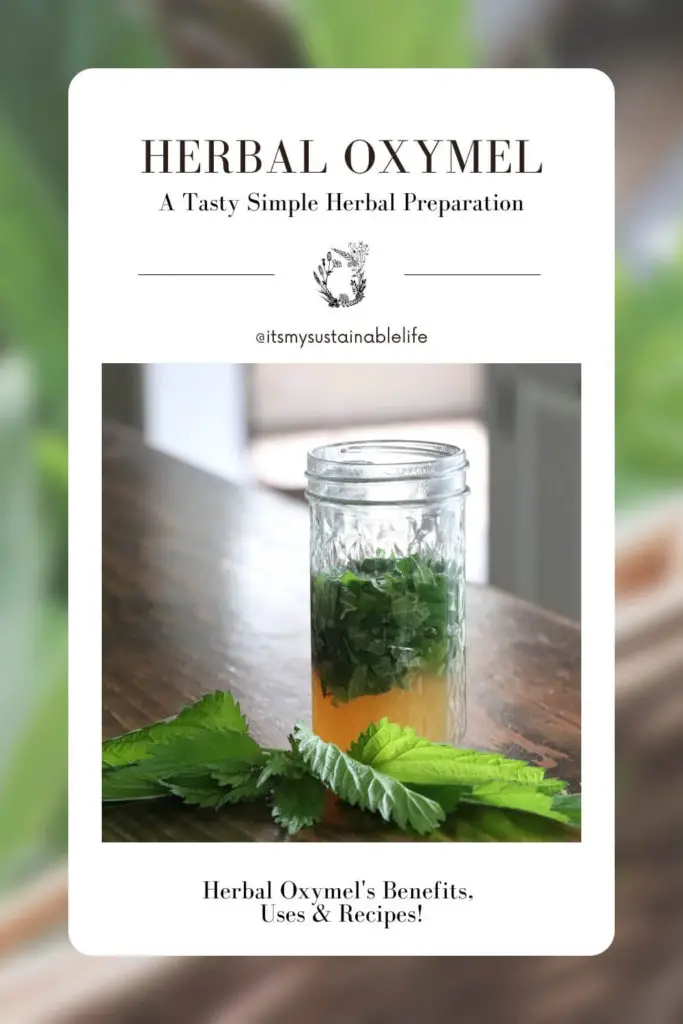
HERBAL OXYMEL USES
By creating your own herbal oxymels, you are in control over creating the taste & flavor of your herbal product. This, for me, is a big positive when it comes to utilizing some of the more pungent, & for me, unpalatable herbs such as nettle.
Over the ages, herbal oxymels have been utilized to assist with respiratory issues, coughs, reducing mucous, and even difficulty breathing (Hippocrates being a fan & prescribing it way back to 400 B.C.E.).
“You will find the drink, called oxymel, often very useful… for it promotes expectoration and freedom of breathing”
Hippocrates 400 B.C.E
Prescribed for issues ranging from gout, insomnia, throat & ear problems, to back & joint soreness in Old England, oxymel was even rubbed on vegetables to ease indigestion.
Today, herbal oxymels & vinegar based drinks are becoming popular once again. In large due to one of the most esteemed modern day herbalists in my opinion, Rosemary Gladstar. Her creation of the amazing home remedy, Fire Cider, one that I make organically & use daily for immune support, and is available to you in my shop should you not want to make your own!
Herbal oxymel, aka an herbal elixir, is very similar to other vinegar based drinks. Shrubs(a fruit, sugar, and vinegar based syrup which is often added to unique cocktails), and switchel (a Colonial-era drink comprised of ginger, vinegar, molasses, water, and sugar) being examples.
How we use herbal oxymels today can vary. Herbal oxymels can be taken straight up or diluted to make fizzies, smoothies, tea, cocktails, and even hot toddy’s! Additionally, they can be used in your culinary dishes, want to create a healthy vinaigrette anyone?
HERBAL OXYMEL INGREDIENT BENEFITS
The 2 base ingredients used in making all herbal oxymels are healing in their own way. Ingredients, both ACV & honey, that have been used for ages in home apothecaries.

HEALTH BENEFITS OF APPLE CIDER VINEGAR
We’ve already determined that ACV acts as an astringent in the body (shoring up the cellular tissues of the body), but organic ACV when left raw, unpasteurized (with the “mother”) and unfiltered is full of beneficial enzymes, trace minerals, and pectin.
In addition to ACV nutritive benefits, ACV also offers us its antimicrobial and antioxidant properties. Although little research has been done to solidify ACV’s place in known alternative therapies, evidence is now being explored to do just that.
- ACETIC ACID – ACV is made through fermenting the sugar from apples. Acetic acid is created through this fermentation, and is believed to be responsible for the majority of ACV benefits
- INHIBITS THE GROWTH OF HARMFUL BACTERIA – ACV has been used as a disinfectant (assists with acne issues) and is a natural preservative
- LOWER BLOOD SUGAR LEVELS – ACV has shown positive results in improving insulin sensitivity & assisting in lowering blood sugar levels after meals
- AID WEIGHT LOSS – ACV can help feeling as though you are full & may aid in losing weight
- HEART HEALTH – Several animal only studies have shown ACV to reduce blood triglycerides, cholesterol, and blood pressure
- AID IN SKIN HEALTH – ACV’s antimicrobial & acidic properties may help to improve skin and prevent infections
ACV also provides potassium, necessary for the normal function of all cells within the body. Potassium, a mineral & type of electrolyte that aids in nerve function and muscles to contract.
Those who include apple cider vinegar into their daily diet several times a day benefit the greatest. However, many do not. Those on medications, struggle with low potassium, experience GERD, or are just unsure of its affects, please check with your doctor or naturopath before taking.
HEALTH BENEFITS OF HONEY
Not all honey is created the same, well, honey, that can be purchased today anyway. Here on the hill I am blessed to have access to an abundance of raw honey created by our own bee hives.
I am rest assured that my honey has not been pasteurized, treated, diluted or altered in any way. It’s raw, untainted, and one of the greatest gifts my homestead offers us. Unlike most honey being offered at your local grocers. As most will not have their own bee hives, look to your local apiculturist (beekeeper) or check with those at your local farmers market to purchase unadulterated raw honey.
I consider myself in good company by utilizing honey for both our nutritional needs and for its medicinal properties. After all most ancient civilizations utilized honey for its medicinal benefits some of which include….
- ANTIOXIDANTS – Antioxidants assist in protecting the body from cell damage due to free radicals, which contribute to aging & development of chronic disease. Compounds within honey, specifically “polyphenols” may play a roll in preventing these developments
- ANTIBACTERIAL & ANTIFUNGAL – Honey naturally contains hydrogen peroxide (antiseptic) and has been shown to kill unwanted bacterial and fungus
- HEAL WOUNDS – Honey, specifically manuka honey, is used in medical settings to treat wounds and is an effective germ killer & tissue regenerator (this type of honey is not store bought, it’s medical grade, inspected, & sterile)
- PHYTONUTRIENT DENSE -Phytonutrients are the compounds within plants that provide protection
- PREBIOTIC – Honey aids with digestive issues including as treatment for Helicobacter pylori (H. pylori), a bacteria linked to stomach ulcers. As a prebiotic, honey nourishes the good bacteria within the intestines crucial for overall health
- SORE THROAT AID – An old sore throat remedy, and for good reason. A go to aid for sore throats AND coughs, research has shown honey to be as effective (and better for you overall in my humble opinion) than that of over-the-counter cough medicine ingredient, dextromethorphan
Honey may be one of the most appreciated and under-valued natural products available to mankind. Although this is a pretty impressive list, it is by no means a complete one. Research is ongoing and I cannot wait for the scientific “proof” to catch up with the rest of us 😊
HERBAL OXYMEL VS HERBAL ELIXIR
Is an herbal oxymel the same as an herbal elixir? Yes. On the other hand, according to Mountain Rose Herbs, not all elixirs are oxymels.
“sipping vinegars like fruity shrubs and gingery switchels are delicious herbal elixirs, but they’re not necessarily sweetened with honey, which is a requirement for oxymels”
Mountain Rose Herbs
HERB CHOICES FOR HERBAL OXYMEL
Most oxymels being made today incorporate herbs, thus making the elixir even more beneficial. And you don’t have to stick with just one. Incorporate several if you like for the relief you are searching for.
When choosing the herbs & ingredients you would like to utilize, give thought to what it is you will be using the elixir for. Coughs & congestion? Think marshmallow root and ginger. Upper respiratory issues or infections? Think rosemary & sage (not for use in pregnant or nursing women).
The following herbs in no particular order, are some suggestions you may want to consider. As with all things herbal related, I encourage you to research, do your homework, and refer to your doctor or naturopath when in doubt...
- ROSEMARY – Rosemary is a great option for those with low energy, circulatory issues, and digestive & nerve issues. Again, rosemary should be avoided for use medicinally when pregnant or nursing.
- THYME – Thyme boasts antiviral & antibacterial properties and is a great choice for those with upper respiratory infections, coughs, & bronchitis.
- SAGE – Sage is a reliable herb that is antifungal, antibacterial, and antiviral. Sage is a great choice if you are experiencing digestive problems (gas, bloating, gastritis, or diarrhea) NOT for pregnant or nursing women and should not be taken for an extended period of time.
- OREGANO – Another upper respiratory rescue plant, oregano contains antibacterial & antiviral qualities.
- GOLDENROD – Goldenrod’s anti-inflammatory properties make it a good choice for those looking for pain and swelling relief, arthritis relief, and those with excezma and other skin conditions. Read more at Foraging And Using Goldenrod.
- YARROW – Yarrow & Its Many Uses covers all and more of this unique herbs benefits. When making oxymels, yarrow is a great choice for reducing fever, stimulating digestion, and healing coughs and lung congestion.
- MINT – Well known as a stomach soother & digestive aid, mint is a wonderful choice for those with digestive issues.
- MULLEIN – Used largely for respiratory relief, mullein is a good choice for coughs, bronchitis, colds, chills, flu, swine flu, fever, allergies, tonsillitis, sore throat, and asthma issues.
- NETTLE – Stinging nettle is allowed to grow in an area all its own here on the hill. And we take full advantage of all its nutrients & medicinal properties in making tea’s, herbal infusions, tinctures, and herbal oxymels. Nettle is known to aid in pain management (think arthritis here), seasonal allergies, and improve overall health!
- PINE NEEDLES – Full of vitamins C & A, white pine contains many different acids, essential oils (terpenes, monoterpenes, sesqueterpenes), resin, & starch. The pine needles also boast of a compound referred as alpha or beta pinene. This compound acts naturally as a decongestant and has anti-inflammatory, antibacterial, antimicrobial, and anxiolytic properties.
Again, you are your own best health advocate. Do you research before beginning any new health routine, ask questions, and decide for yourself.
FLORAL CHOICES FOR MAKING OXYMEL
When making oxymel you are not only limited to utilizing the addition of medicinal herbs. Florals can be used as well, many having beneficial properties available to use as well!
Here are a few favorite choices in no particular order….
- MONARDA (BEE BALM) – A great choice for sore throats, fever, and congested coughs due to its antibacterial properties.
- ROSE PETALS – The petals of the organic rose plant are astringent and anti-inflammatory, high in antioxidants, and contain antimicrobial properties. Those with anxiety & digestive issues should consider utilizing the healing properties of rose petals. You may be interested in taking a look at how I create my own Rose Oil & Rose Water.
- ELDERFLOWERS – One of the favorite oxymels here on the hill to make each year as an addition to seltzer’s & cocktails. Not only does elderflower lend a light refreshing flavor to drinks, but its medicinal properties used for swollen sinuses (sinusitis), colds, influenza (flu), swine flu, bronchitis, diabetes, and constipation should be noted.
- CALENDULA – Calendula, a good choice for those with skin issues (eczema/psoriasis, & acne), fevers, and more.
- LAVENDER – Chock full of anti-inflammatory, antibacterial, anti-fungal, as well as antioxidant properties, lavender makes for an amazing choice when making a floral oxymel.
- ECHINACEA – Echinacea may be one of the most well-known floral plants used for immune support. It has also been shown to improve immunity, blood sugar, anxiety, inflammation and skin health.
HOW TO MAKE HERBAL OXYMEL
The directions for making your own herbal oxymels or floral ones could not be more simple. There are, however, a few different approaches to making them that you can choose from.
EQUIPMENT NEEDED FOR MAKING AN HERBAL OXYMEL
Well, this will be short and sweet as really no special equipment is needed other than that which can be up-cycled or you have available in your kitchen cupboard already!
- GLASS JAR – Although you can choose to up-cycle and re-use a simple glass jar, like you know, I love my Ball® Mason Jars.
- JAR COVER – If you are using a Ball® Mason Jar, you will need a cover.
- STRAINER – I prefer using a fine mesh strainer
- *OPTIONAL – Cheesecloth or re-useable nutbag
NOTE: If you have on hand only the traditional 2 piece mason jar lid and screw cap, you will want to place a piece of either parchment paper or wax paper in between the top of the jar and the screw cap as vinegar will cause the lids to rust.
When it comes to covers for my mason jars for storage and making my concoctions, I prefer to use re-useable plastic screw tops.
But these wooden top ones sure look intriguing!
OPTIONS FOR MAKING HERBAL OXYMEL
Traditionally in the past, oxymels tended to use quite a lot of honey to vinegar, sometimes 5:1! For most of us, myself included, this would result in a way too sweet elixir.
When it comes to proportions, I usually stick with an easy to remember 1:1:1 ratio of herbs, organic raw apple cider vinegar, and raw honey. This is, however, not a hard and fast rule. Feel free to mix up the proportions to suit your tastes and needs.
How you make & prepare your herbal oxymel is totally up to you. Personally, I like the more traditional folk method, or what I refer to as my slow method. I have made a couple of my favorite combinations, a spicy sage & ginger (recipe below) & my nettle oxymel (recipe below) as an examples of this method.
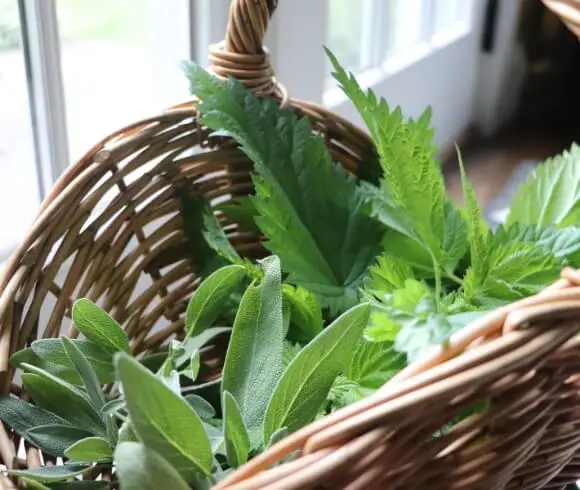
TRADITIONAL FOLK METHOD FOR MAKING HERBAL OXYMEL
To use this method of preparation simply take 1 part herb of choice, 1 part raw organic apple cider vinegar, and 1 part raw honey.
STEP 1 – Place your washed, dried, fresh herb of choice into a clean, dry jar. The herb should fill 1/4 to 1/3 of the way full. I like to give my herb(s) a quick rough chop to help release the beneficial oils.
STEP 2 -Add any optional ingredients to the jar.
STEP 3 – I like to combine my honey & vinegar in a pourable measure & whisk to combine well. Add this combo to your jar of herbs, striving for a rough ratio of 1:3 herbs to vinegar/honey mix.
STEP 4 – Cover the jar (remember to add your parchment or wax paper barrier when using traditional metal lids) and give the jar a good shake. Remember to label and date your jar!
STEP 5 – Place the jar in a cool, dark cupboard, remembering to visit it every few days and shake well. Let your oxymel marinate for at least 2 weeks but preferably 4-6 weeks.
STEP 6 – Using a fine mesh strainer, optionally lined with cheesecloth or a re-useable nutbag, strain the oxymel from the herb, obviously reserving the liquid, and making sure every ounce is squeezed out. Compost the herb or better yet, give your chickens if you raise them a treat 😊
Store in a cool, dark cupboard for 6 months to a year.
QUICK METHOD FOR MAKING HERBAL OXYMEL
Many like myself enjoy making infused vinegars or honey when my herb garden is in full production. If this includes you, you have half the work of creating your own herbal oxymel already done!
STEP 1 – Using a ratio of 1:1 infused product (honey, vinegar) place into a jar & combine well.
STEP 2 – Cover, label and store in a cool dark place until you are ready to use it.
Don’t have prepared infused vinegar? No problem! Simply place herb of your choice into a sauce pan and double the amount of ACV. Gently bring to a boil being careful not to inhale the intense steam that’s created. Reduce to simmer for 30 to 40 minutes. Cool to room temperature & strain composting the remaining herbal mixture.

Your quick method of infusing vinegar is now ready to use in your oxymel!
HERBAL OXYMEL BASE USING TINCTURES
Yes you can use tinctured herbs when making herbal oxymels! Follow these simple steps to create your own.
Combine 2 C honey and 1 C vinegar in equal portions into a saucepan and simmer until thick like a syrup. Remove from the heat, and add your tincture using a ratio of 1:3, tincture to honey/vinegar mixture, stirring well.
Store in a cool, dark place or alternatively in the refrigerator being sure to give it a good shake prior to taking.
HERBAL OXYMEL RECIPES
The following two herbal oxymel recipes are ones we love to make here on the hill. I hope you give them a try yourself!
SPICY SAGE & GINGER OXYMEL RECIPE
I make this herbal oxymel to have on hand for when we are feeling the sniffles coming on or feeling particularly out of sorts with digestive issues.
To make my spicy sage & ginger oxymel, simply fill a jar 1/3 of the way with lightly chopped fresh sage leaves, 1/3 ACV, and 1/3 raw honey, 1 inch piece of ginger chopped, and 1 hot pepper sliced down the middle added.
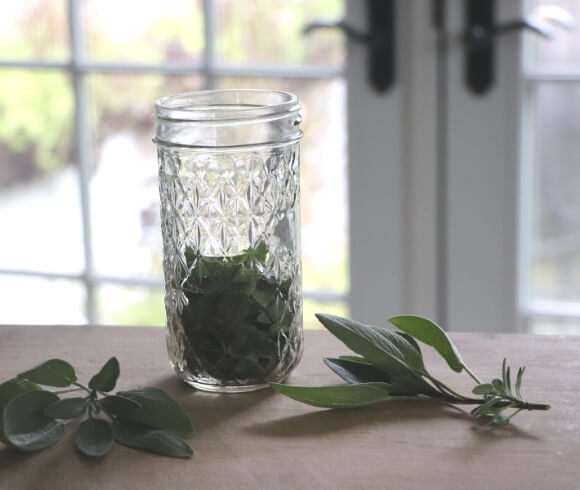
Following the traditional folk method of making the herbal oxymel, once strained, this spicy sage & ginger oxymel will last stored in a dark, cool cupboard or space for 6 months to a year. For a longer shelf life, store in the refrigerator.
TO USE: I like to add this to my arsenal against colds etc., by using this oxymel as I would my elderberry syrup. Adults can take 1-2 tablespoons 2-3 x per day as needed when feeling symptoms.
NETTLE OXYMEL RECIPE
For my nettle oxymel I follow the traditional folk method for making herbal oxymel and use 1:1:1 ratio of herb, vinegar, and honey. The image below is only half way filled with my vinegar/honey, rest assured I used all the proper ratio’s in my final product!
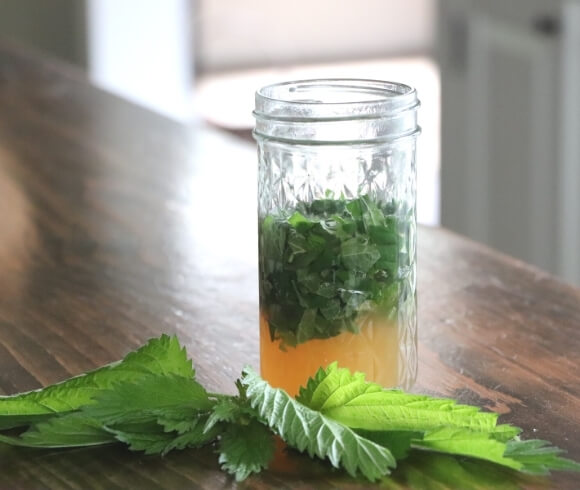
You can make this oxymel spicy as well by using 1 sliced hot pepper, and 1 teaspoon cayenne pepper to the mix. Allow to steep in a cool, dark cupboard for 4-6 weeks, strain, jar, and label.
My nettle oxymel recipe will keep for 6 months to a year when stored properly.
TO USE: Take 1 tablespoon per day as a preventative & supportive and up that to 2 to 3 x per day when feeling symptoms coming on.
USEAGE NOTE: Alternatively, should you find the oxymel(s) to still be too intense to take directly from the spoon, feel free to add your dosage to a warm cup of water to enjoy!
CONTRAINDICATIONS & PRECAUTIONS FOR TAKING HERBAL OXYMELS
As with any new herbal regime, always defer to your primary care, physician, or naturopath when in doubt. Again, do you due diligence, research, research, and yes, research.
Research specific herbs, their efficacy, their dosage recommendations, and importantly, their precautions.
When allergic to a plant, a plant family, honey, or any other ingredient in an herbal formula, obviously refrain from using that preparation. Standard commonsense & precautions should be recognized when using.
Great advice should be taken from Paul Pitchford, author of Healing With Whole Foods. Refrain from using herbal oxymels when you are experiencing or feeling…
- weak digestion indicated by watery stools
- especially frail
- generalized muscle weakness
- have rheumatism
- don’t take alone for long periods of time
CAN HERBAL OXYMELS BE GIVEN TO CHILDREN
Herbal oxymels can generally be given to children over the age of one with some guidelines.
Be sure that the herbs used in creating the herbal oxymel are appropriate & safe for children.
As vinegar based flavors can sometimes be difficult for young ones to take, feel free to add additional honey for those over the age of 1 without allergies.
Obviously, the dosage amount should be reduced due to their small stature.
Again, oxymels should not be given to children under the age of one due to the ingredient of raw honey.
Herbal oxymels are fun to make, and are full of health benefits & uses! Hopefully, you will make some to have at hand.
Love, Light & Laughter ~

Enjoy this article? Please consider sharing it on your favorite social media channel! Want more? Subscribe below for the occasional update with all the “happenings on the hill”!
DISCLAIMER
Recommendations and or suggestions made by this blog regarding husbandry and or herbal remedies etc. are not meant to replace solid advice from qualified professionals. None of the information on this blog has been evaluated by the FDA. Products or remedies mentioned are not intended to diagnose, treat, cure or prevent disease. Please do your due diligence. Research, talk to qualified professionals and proceed at your own risk.

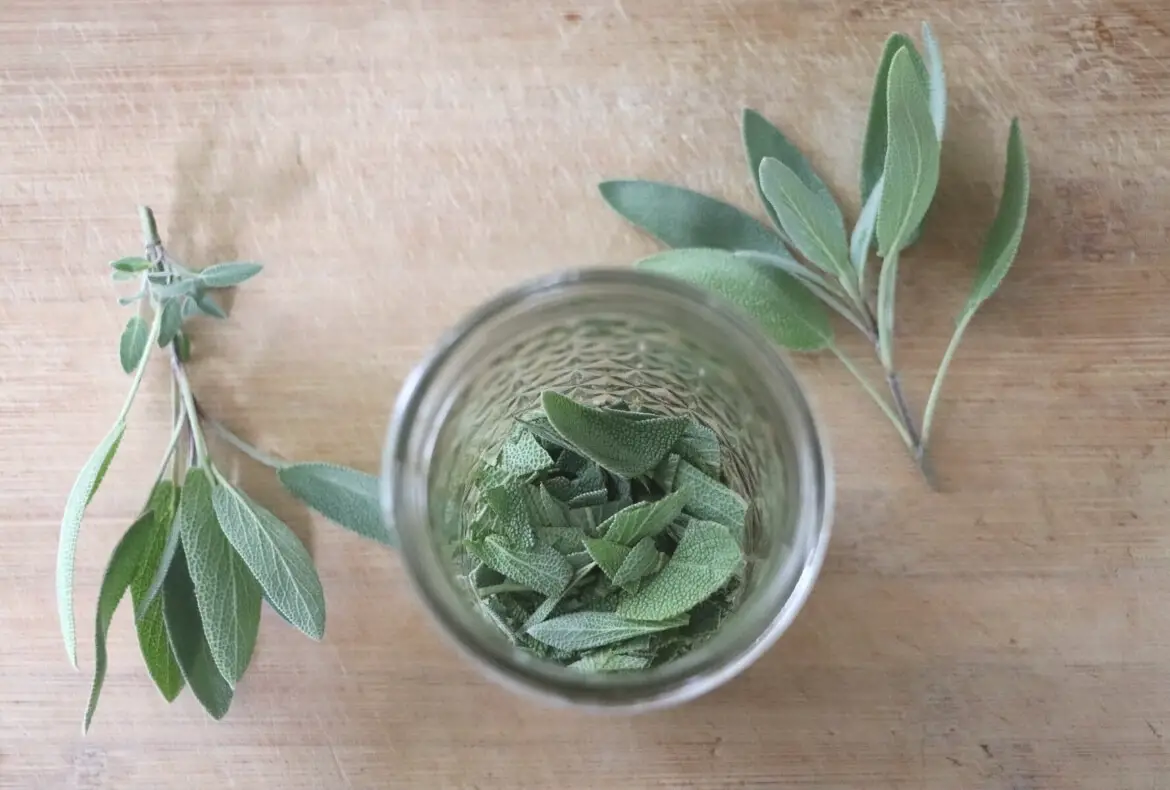
2 comments
I am always in awe of your knowledge! This is such a great way to keep the family healthy. I have all of this stuff in my pantry!
This was very knowledgable article and fully enjoyed it! My mom made sauves with plantain (the kind that grows in grass) and I still use it to this day! She also made a “super drink” when we were sick and worked like a charm. I’m definitely going to check out your Etsy shop too! 🙂